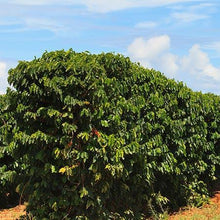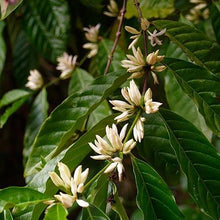
A Cup of Joe, Organic and Right at Home
Fresh coffee beans after the first season of growth? It’s easy with the organic Arabica Coffee Plant. Proper care means your own homemade coffee with the extra perk of organic growth – no harsh sprays or chemicals required.
Effortless to grow, no matter where you live. This instant-favorite houseplant produces vibrant beans against the bold backdrop of dark green, gleaming foliage. A focal point in any space and bringer of bountiful beans, the Arabica Coffee Plant is a must-have for the coffee lover.
Harvest fresh, aromatic coffee beans right from your backyard. During the ripening process, these eye-catching coffee beans transition from green to yellow, then a rich orange hue, then finally to deep, dramatic red. And not only does the Arabica Coffee Plant produce fresh and fragrant beans, but it also brings flourishing, jasmine-scented blooms during spring.
Once you’ve picked your succulent, savory Arabica Coffee Beans, dry them in your roaster or oven. After the beans have cooled, they’re ready to grind and brew into a hot, homemade cup of Joe. Growing and brewing your own coffee has never been more effortless and healthful.
Plus, with minimal maintenance and hassle-free growth, the Arabica Coffee Plant is even more desirable. Plant your new Arabica Coffee Plant in a pot, indoors or outdoors. If you reside in growing zones 9-11, place the Arabica Coffee Plant in the ground and ensure you protect it if temperatures drop below 30 degrees F. Place it in a room with windows during the winter, or grow it indoors year-round. The possibilities are endless with the adaptable, versatile Arabica Coffee Plant. Free of harmful sprays and harsh chemicals, the organic Arabica Coffee Plant offers the freshest beans around.
Order yours today for a delicious, homegrown cup of coffee, right from your backyard!
Planting & Care
The Arabica coffee plant is an evergreen shrub originating from the highlands of Ethiopia and today provides a serious percentage of the world's coffee production.
The beans themselves are pairs of flat, elongated seeds found inside the red, cherry-like fruit. The coffee plant grows to a mature height of about 6 feet and a width of 3 feet. It's primarily grown outdoors in shaded areas in the more temperate regions of the country.
However, they can be successfully potted and grown indoors in growing zones that have a colder winter season. Nine months after the coffee plant begins to flower is when the fruiting process begins with beautiful array of fragrant white blooms.
Choosing a Location: Arabica coffee plants are self-pollinating, but will give you a better harvest with an additional plant nearby. For the best results use a sandy, slightly acidic, well draining soil and choose a location with filtered sunlight for your coffee plant.
Planting Directions (potted): The Arabica coffee is actually considered to be one of the easiest, hardiest houseplants to manage.
1) Coffee plants prefer indirect but bright light. It should be placed near an east-facing window but not directly in it.
2) Select a good organic potting soil that is rich enough to feed the plant. Make sure that your soil and your pot both have good drainage.
3) If your tree is at least 24-36 inches tall then plant into a half wine barrel sized pot or a container that is similar in size. The root system on the coffee plant is extensive and it will need this large space to support full production.
4) Keep the humidity up around the coffee plant by setting it on a water filled pebble tray in its early stages. A light misting with a water bottle in the evenings is great for a more mature plant.
Planting Directions (in ground):
1) Before planting, water the coffee plant thoroughly.
2) Dig your hole at least 2 feet wide and just as deep as the root system.
3) Carefully comb the roots with your hand to loosen them and straighten larger roots before placing in the hole.
4) Place your coffee plant upright in the hole making sure it's not at an angle and then gently back-fill half way with soil.
5) Gently press down the soil and fill the hole with water. This will bring the soil into closer contact with the root system. Let all the water drain and then finish back-filling the hole.
6) Firmly press down the soil but avoid packing it too tightly as this may damage the young roots. Keep the soil of the planting hole slightly heaped above the undisturbed soil, as it will settle down on its own a bit after planting.
7) Water the planting site with about a gallon of water, a garden watering pot works perfectly. Add mulch to help maintain a moist soil but keep it about a foot away from the base of the plant as this promotes rot and fungus.
Watering: Arabica coffee plants really enjoy water but do not like to be water logged or over saturated. For a potted coffee plant drench twice weekly with warm water until it comes out of the bottom of your pot and then drizzle over the top to simulate rain.
Coffee planted in ground will require watering 2-3 times weekly for the first 4-6 weeks with about a gallon of warm water as well. One of the perks of coffee plants is the leaves can be an indicator if more water is needed. If the leaves curl upwards, seem crispy or dry is a sign of under watering. Drooping leaves that appear too heavy for the plant to hold up that turn a shade of dark brown or black indicate overwatering.
Fertilizing: If your Arabica coffee plant is in the ground, fertilize it twice a year. Plants in the ground plants should be fed in the spring and summer with a slow releasing fertilizer around the base of the plant. Potted coffee plants need to be fertilized every two weeks during the growing season with a low concentration of fertilizer. The best results come from using a formula like 10-10-10 or an orchid fertilizer but try to use it sparingly. During early stages of growth add a bit more nitrogen.
Pruning: Your coffee plant will need some pruning on occasion; Arabica should be grown as a single stem. "Suckers" can start growing near the base of the plant and should be removed as soon as possible with a sterilized cutting tool. A basic rubbing alcohol is recommended for sterilizing your pruners or loppers.
As your coffee plant matures you'll want to prune off any primary branches that droop and touch the ground by cutting them back to the secondary branch that they are closest to. Maintain well-spaced secondary branches on each primary branch and remove any of the dead, weak or damaged branches.
Harvesting Coffee Beans: The cherries of your Arabica coffee plant take roughly nine months to fully ripen. The best way to harvest is by selective picking, where you select the best, ripest cherries for harvesting by hand. Coffee cherries don't mature all at the same time so it's necessary to pick them over the course of several days to remove your ripened cherries. the cherries are considered ripe when their skin fully turns red.
Squeeze the cherries in order to get the seeds or coffee beans out and place them into a bowl of water for 24 hours. This will make the remaining pulp stuck to the beans soft and easier to remove once the beans have fully dried. Place your beans on some newspaper and let them dry slowly. You can place them in the sun but be cautious that you don't bake them. Also, be sure to stir them around so they will dry evenly. They will reach a dry, stable condition in about a week. Repeat the process as necessary until all of your cherries have been picked and dried. When your beans are done they will be hard, almost brittle and if they're still soft at all, then they aren't ready yet.
Americans consume more than a third of the whole world's coffee and yet nearly none of it is grown within our country. You can become your own personal barista with the addition of this plant to your home.
The Arabica coffee plant isn't solely useful for the beans it produces, because the cherries that form around the beans are a delectable treat that can be enjoyed while harvesting them. The cherries are very high in plant polyphenols and antioxidants, which are known for their disease-fighting and anti-aging capabilities.
The antioxidant levels are greater than cranberries, pomegranate, green tea and raspberries, which regulate blood sugar, lower cholesterol, treats diabetes, asthma and even depression.
Not only will your coffee plant bring you the freshest coffee available and provide incredibly healthy, sweet fruit, it will also bring you a sweet jasmine-like aroma when the blooms emerge. It's a fantastic addition to your home or garden!








